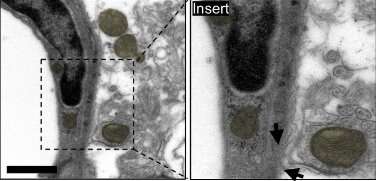Researchers at the Perron Institute and The University of Western Australia have discovered a new set of cells that can protect blood vessel structure in the central nervous system (CNS) known as the blood-brain barrier. Their findings have been published in the journal Science Advances.
“We identified a new set of astrocytes (type of brain cells) that can control the integrity of the blood-brain barrier,” said one of the senior first authors, Professor Minghao Zheng, head of Brain and Bone Axis Research at the Perron Institute and UWA.
“The blood-brain barrier is a network of blood vessels that supplies essential nutrients to the brain and protects it from circulating toxins and pathogens. With age, or in brain disorders, the function of the blood-brain barrier is reduced.
“This newly discovered subset of astrocytes expressed a protein found in bone tissue called dentin matrix protein 1 (DMP-1).
“These cells generate ‘endfeet’ and transfer mitochondria (energy generating cells) to endothelial cells which line the blood vessels of the CNS.

“Reduction in the function of these astrocytes inhibited mitochondrial transfer and caused leakage of the blood-brain barrier. Mitochondrial transfer from astrocytes to blood vessel cells was identified as crucial to the maintenance of the blood-brain barrier.
“Our findings give new insights into the cellular framework that underpins the breakdown of the blood-brain barrier that occurs in aging and disease, and provide a target for the development of treatment regimes.”
More information:
Delin Liu et al, Regulation of blood-brain barrier integrity by Dmp1 -expressing astrocytes through mitochondrial transfer, Science Advances (2024). DOI: 10.1126/sciadv.adk2913
Citation:
Scientists discover a new set of cells that control the blood-brain barrier (2024, July 1)
retrieved 1 July 2024
from https://medicalxpress.com/news/2024-07-scientists-cells-blood-brain-barrier.html
This document is subject to copyright. Apart from any fair dealing for the purpose of private study or research, no
part may be reproduced without the written permission. The content is provided for information purposes only.

